Advancements in Remote Alpha Radiation Detection: Alpha-Induced Radio-Luminescence Imaging with Enhanced Ambient Light Suppression
Abstract
1. Introduction
1.1. Alpha Particles
1.2. Damage to Humans from Alpha Particles
1.3. Challenges in Nuclear Industry and Forensics
- Preventing radiological terrorist attacks.
- Managing both intentional and accidental radiological contaminations, along with subsequent forensic analysis.
- Safeguarding public health and the environment from alpha radiation during decommissioning processes.
- Conducting remote assessments of nuclear waste conditions.
1.4. Alpha-Induced Radio-Luminescence
1.5. Previous Studies of Alpha Detection
2. Material and Methods
2.1. Alpha Sources
- A 29 kBq Am-241 alpha source, extracted from a smoke detector, with a diameter of 2.7 mm. This source was attached to a 3D-printed stand with a double side sticker. At the bottom of the stand was a metal gasket, which served as a controlled reflection surface.
- A 3 MBq Am-241 alpha source with a diameter of 12.5 mm. It was placed at the center of a 3D-printed stand. No reflection surface was attached as there was a metal ring around this source, which served as a controlled surface.
2.2. Large Lens Detection System
2.2.1. Camera
- Resolution: pixels, each of size 13 μm × 13 μm, 8 × 8 pixel binning was used during the experiment to reduce the read noise per pixel; therefore, the modified resolution is pixels.
- The quantum efficiency (QE), which is the measure of the effectiveness of an imaging device to convert incident photons into electrons, is 57% on average within the 300–400 nm range (refer to Figure 3).
2.2.2. Optical Configuration
- 27-513 Condenser Lens (Edmund Optics, York, UK) made from N-BK7 glass: 200 mm diameter, 400 mm focal length, and approximately 70% transmission at 337 nm.
- LA4545-UV Fused Silica Plano-Convex Lens (Thorlabs Ltd., Lancaster, UK): 50.8 mm diameter, 100 mm focal length, AR Coating for the 245–400 nm range ensuring minimal reflection, and about 95% transmission at 337 nm.
2.3. Glovebox Imaging System
2.3.1. Camera
2.3.2. Optical Configuration
- A LB4592-UV 2-inch diameter UV fused silica lens (Thorlabs Ltd., Lancaster, UK) with a focal length of 60 mm.
- LA4148-UV (Thorlabs Ltd., Lancaster, UK), also crafted from UV fused silica, with a 1-inch diameter and a focal length of 50 mm.
2.3.3. Power Supply
2.3.4. Glovebox
2.4. Filter Selection
2.5. Light Intensity Measurements in Different Environments
2.6. Image Processing and Analysis
3. Results
3.1. Blocking Rate Required to Suppress Ambient Light
3.2. Imaging of Alpha RL under LED Room Light
3.3. Separation of Two Alpha Sources
3.4. Imaging of Alpha RL Inside a Glovebox
4. Conclusions
Author Contributions
Funding
Institutional Review Board Statement
Informed Consent Statement
Data Availability Statement
Conflicts of Interest
Abbreviations
| RL | Radio-luminescence |
| PMT | Photomultiplier tube |
| CCD | Charge-coupled device |
| CWL | Center Wavelength |
| FWHM | Full Width at Half Maximum |
| OD | Optical Density |
| UV | Ultraviolet |
References
- L’Annunziata, M.F. 1—Alpha Radiation. In Radioactivity; L’Annunziata, M.F., Ed.; Elsevier Science B.V.: Amsterdam, The Netherlands, 2007; pp. 71–84. [Google Scholar] [CrossRef]
- Knoll, G.F. Radiation Detection and Measurement; John Wiley & Sons: Hoboken, NJ, USA, 2010. [Google Scholar]
- Scott, B. Radiation Toxicology, Ionizing and Nonionizing. In Encyclopedia of Toxicology, 3rd ed.; Wexler, P., Ed.; Academic Press: Oxford, UK, 2014; pp. 29–43. [Google Scholar] [CrossRef]
- Harrison, J.; Fell, T.; Leggett, R.; Lloyd, D.; Puncher, M.; Youngman, M. The polonium-210 poisoning of Mr Alexander Litvinenko. J. Radiol. Prot. 2017, 37, 266. [Google Scholar] [CrossRef]
- Loucas, B.D.; Durante, M.; Bailey, S.M.; Cornforth, M.N. Chromosome damage in human cells by γ rays, α particles and heavy ions: Track interactions in basic dose-response relationships. Radiat. Res. 2013, 179, 9–20. [Google Scholar] [CrossRef]
- Sawant, S.; Randers-Pehrson, G.; Geard, C.; Brenner and, D.; Hall, E. The bystander effect in radiation oncogenesis: I. Transformation in C3H 10T1/2 cells in vitro can be initiated in the unirradiated neighbors of irradiated cells. Radiat. Res. 2001, 155, 397–401. [Google Scholar] [CrossRef] [PubMed]
- Eisenbud, M.; Gesell, T.F. Environmental Radioactivity from Natural, Industrial and Military Sources: From Natural, Industrial and Military Sources; Elsevier: Amsterdam, The Netherlands, 1997. [Google Scholar]
- Crompton, A.J.; Gamage, K.A.; Jenkins, A.; Taylor, C.J. Alpha particle detection using alpha-induced air radioluminescence: A review and future prospects for preliminary radiological characterisation for nuclear facilities decommissioning. Sensors 2018, 18, 1015. [Google Scholar] [CrossRef] [PubMed]
- Game Changers Challenge Statement: Stand-Off Alpha Radiation Detection under Daylight Conditions. Available online: https://www.gamechangers.technology/challenge/Stand-off_alpha_radiation_detection_under_daylight_conditions (accessed on 8 November 2023).
- Radhound: Multi-Purpose Digital Radiation Meter. Available online: https://www.southernscientific.co.uk/products-by-manufacturer/southern-scientific/radhound (accessed on 8 November 2023).
- Crompton, A.J. Stand-Off Detection of Alpha-Induced Air-Radioluminescence even under Daylight Conditions; Lancaster University: Lancaster, UK, 2019. [Google Scholar]
- Sand, J.; Nicholl, A.; Hrnecek, E.; Toivonen, H.; Toivonen, J.; Peräjärvi, K. Stand-off radioluminescence mapping of alpha emitters under bright lighting. IEEE Trans. Nucl. Sci. 2016, 63, 1777–1783. [Google Scholar] [CrossRef]
- Thompson, C.; Barritt, E.; Shenton-Taylor, C. Predicting the air fluorescence yield of radioactive sources. Radiat. Meas. 2016, 88, 48–54. [Google Scholar] [CrossRef]
- Dandl, T.; Heindl, T.; Ulrich, A. Fluorescence of nitrogen and air. J. Instrum. 2012, 7, P11005. [Google Scholar] [CrossRef]
- Huggins, W.; Huggins, M.L. Further observations on the spectrum of the spontaneous luminous radiation of radium at ordinary temperatures. Proc. R. Soc. Lond. 1904, 72, 409–413. [Google Scholar] [CrossRef]
- Baschenko, S.M. Remote optical detection of alpha particle sources. J. Radiol. Prot. 2004, 24, 75. [Google Scholar] [CrossRef]
- Ihantola, S.; Sand, J.; Peräjärvi, K.; Toivonen, J.; Toivonen, H. Principles of UV–gamma coincidence spectrometry. Nucl. Instrum. Methods Phys. Res. Sect. A Accel. Spectrometers Detect. Assoc. Equip. 2012, 690, 79–84. [Google Scholar] [CrossRef]
- Inrig, E.; Koslowsky, V.; Andrews, B.; Dick, M.; Forget, P.; Ing, H.; Hugron, R.; Wong, L. Development and testing of an air fluorescence imaging system for the detection of radiological contamination. Proc. Aip Conf. Proc. 2011, 1412, 393–400. [Google Scholar]
- Klose, A.; Luchkov, M.; Dangendorf, V.; Krasniqi, F.; Lehnert, A.; Walther, C. On the way to remote sensing of alpha radiation: Radioluminescence of pitchblende samples. J. Radioanal. Nucl. Chem. 2022, 331, 5401–5410. [Google Scholar] [CrossRef]
- Kume, N.; Sumita, A.; Sakamoto, N.; Hoshi, T.; Okazaki, K.; Miyadera, H.; Miyahara, Y.; Nakai, Y. Alpha emitter detection systems using a UV light detector. Appl. Opt. 2022, 61, 1414–1419. [Google Scholar] [CrossRef] [PubMed]
- Li, N.; Zhang, N. Remote detection of alpha radiation source by optical method. Optoelectron. Lett. 2023, 19, 405–409. [Google Scholar] [CrossRef]
- Luchkov, M.; Dangendorf, V.; Giesen, U.; Langner, F.; Olaru, C.; Zadehrafi, M.; Klose, A.; Kalmankoski, K.; Sand, J.; Ihantola, S.; et al. Novel optical technologies for emergency preparedness and response: Mapping contaminations with alpha-emitting radionuclides. Nucl. Instrum. Methods Phys. Res. Sect. A Accel. Spectrometers Detect. Assoc. Equip. 2023, 1047, 167895. [Google Scholar] [CrossRef]
- Crompton, A.J.; Gamage, K.A.; Bell, S.; Wilson, A.P.; Jenkins, A.; Trivedi, D. First Results of Using a UVTron Flame Sensor to Detect Alpha-Induced Air Fluorescence in the UVC Wavelength Range. Sensors 2017, 17, 2756. [Google Scholar] [CrossRef] [PubMed]
- Chichester, D.L.; Watson, S.M. Multispectral UV-visual imaging as a tool for locating and assessing ionizing radiation in air. IEEE Trans. Nucl. Sci. 2011, 58, 2512–2518. [Google Scholar] [CrossRef]
- Feener, J.S.; Charlton, W.S. Preliminary results of nuclear fluorescence imaging of alpha and beta emitting sources. In Proceedings of the 2013 3rd International Conference on Advancements in Nuclear Instrumentation, Measurement Methods and their Applications (ANIMMA), Marseille, France, 23–27 June 2013; pp. 1–8. [Google Scholar]
- Kerst, T.; Sand, J.; Ihantola, S.; Peräjärvi, K.; Nicholl, A.; Hrnecek, E.; Toivonen, H.; Toivonen, J. Standoff alpha radiation detection for hot cell imaging and crime scene investigation. Opt. Rev. 2018, 25, 429–436. [Google Scholar] [CrossRef]
- Krasniqi, F.S.; Kerst, T.; Leino, M.; Eisheh, J.T.; Toivonen, H.; Röttger, A.; Toivonen, J. Standoff UV-C imaging of alpha particle emitters. Nucl. Instrum. Methods Phys. Res. Sect. A Accel. Spectrometers Detect. Assoc. Equip. 2021, 987, 164821. [Google Scholar] [CrossRef]
- Sand, J.; Ihantola, S.; Peräjärvi, K.; Nicholl, A.; Hrnecek, E.; Toivonen, H.; Toivonen, J. Imaging of alpha emitters in a field environment. Nucl. Instrum. Methods Phys. Res. Sect. A Accel. Spectrometers Detect. Assoc. Equip. 2015, 782, 13–19. [Google Scholar] [CrossRef]
- Ivanov, O.P.; Stepanov, V.E.; Smirnov, S.V.; Volkovich, A.G. Development of method for detection of alpha contamination with using UV-camera “DayCor” by OFIL. In Proceedings of the 2011 IEEE Nuclear Science Symposium Conference Record, Valencia, Spain, 23–29 October 2011; pp. 2192–2194. [Google Scholar]
- 200 mm Dia × 400 mm Focal Length, PCX Condenser Lens. Available online: https://www.edmundoptics.co.uk/p/200mm-dia-x-400mm-focal-length-pcx-condenser-lens/1019/ (accessed on 25 October 2023).
- UV Fused Silica Plano-Convex Lenses, UV AR-Coated. Available online: https://www.thorlabs.com/newgrouppage9.cfm?objectgroup_id=3569 (accessed on 25 October 2023).
- Lamadie, F.; Delmas, F.; Mahe, C.; Girones, P.; Le Goaller, C.; Costes, J. Remote alpha imaging in nuclear installations: New results and prospects. IEEE Trans. Nucl. Sci. 2005, 52, 3035–3039. [Google Scholar] [CrossRef]
- Abdel-Rahman, F.; Okeremgbo, B.; Alhamadah, F.; Jamadar, S.; Anthony, K.; Saleh, M.A. Caenorhabditis elegans as a model to study the impact of exposure to light emitting diode (LED) domestic lighting. J. Environ. Sci. Health Part A 2017, 52, 433–439. [Google Scholar] [CrossRef] [PubMed]

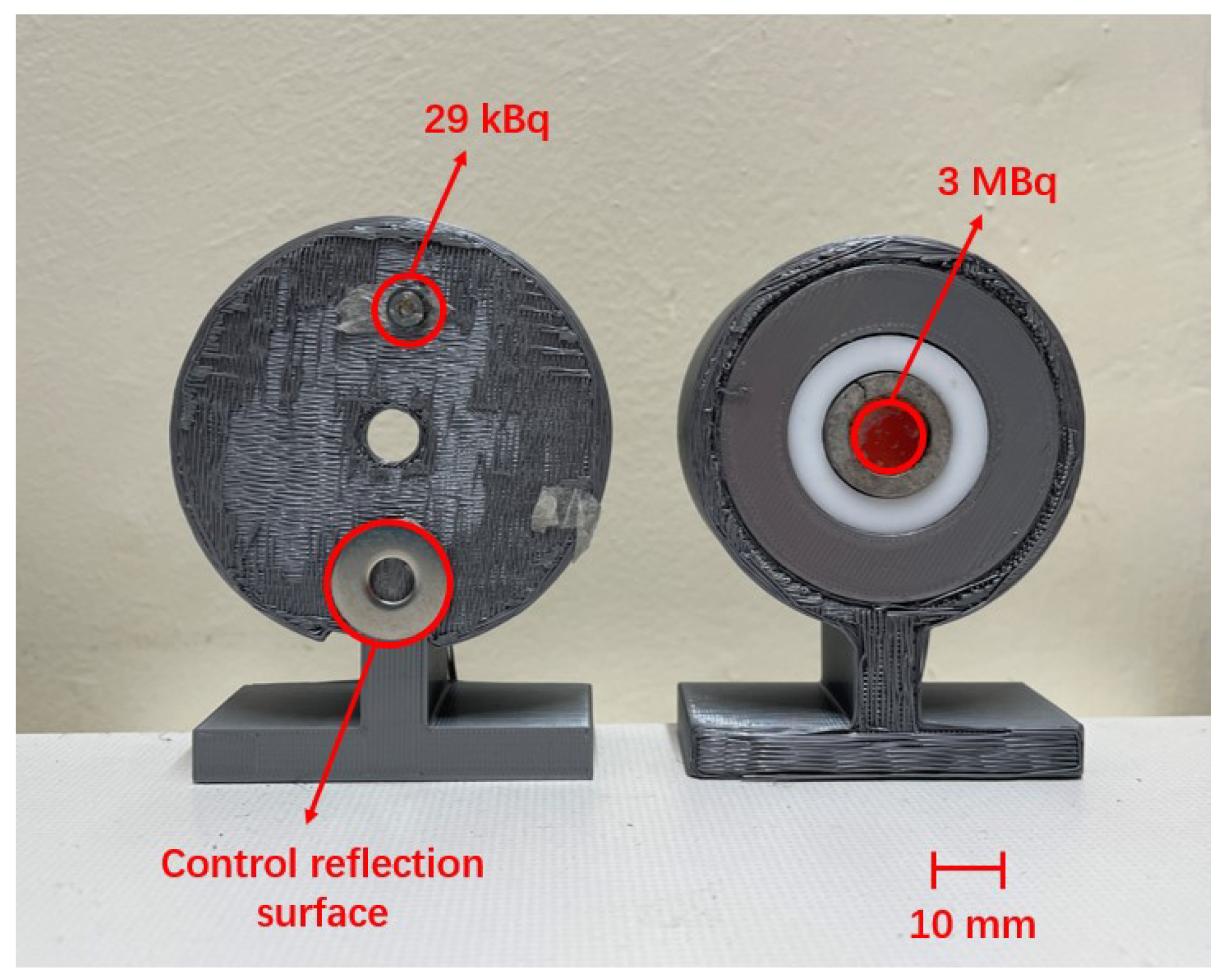
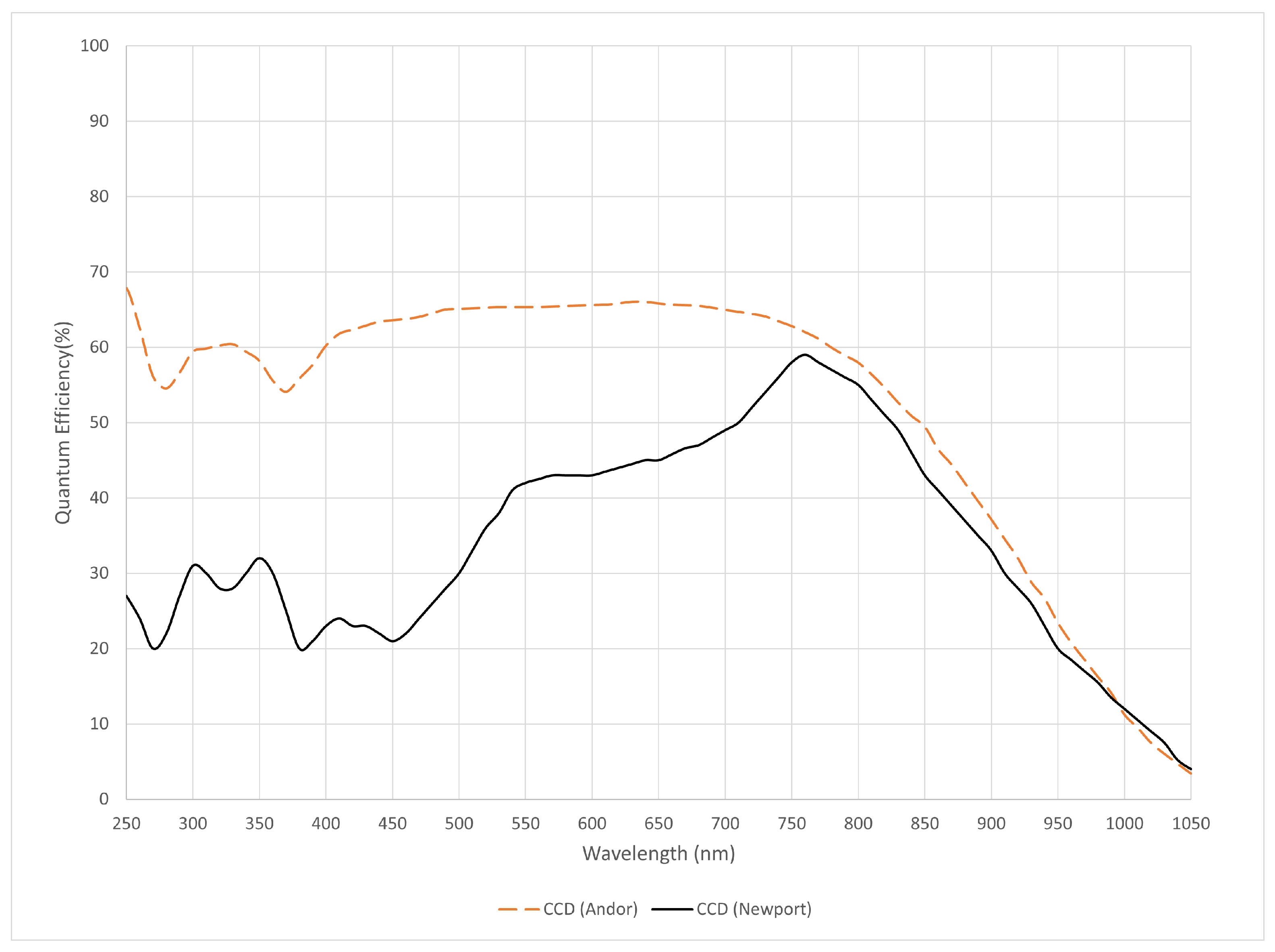
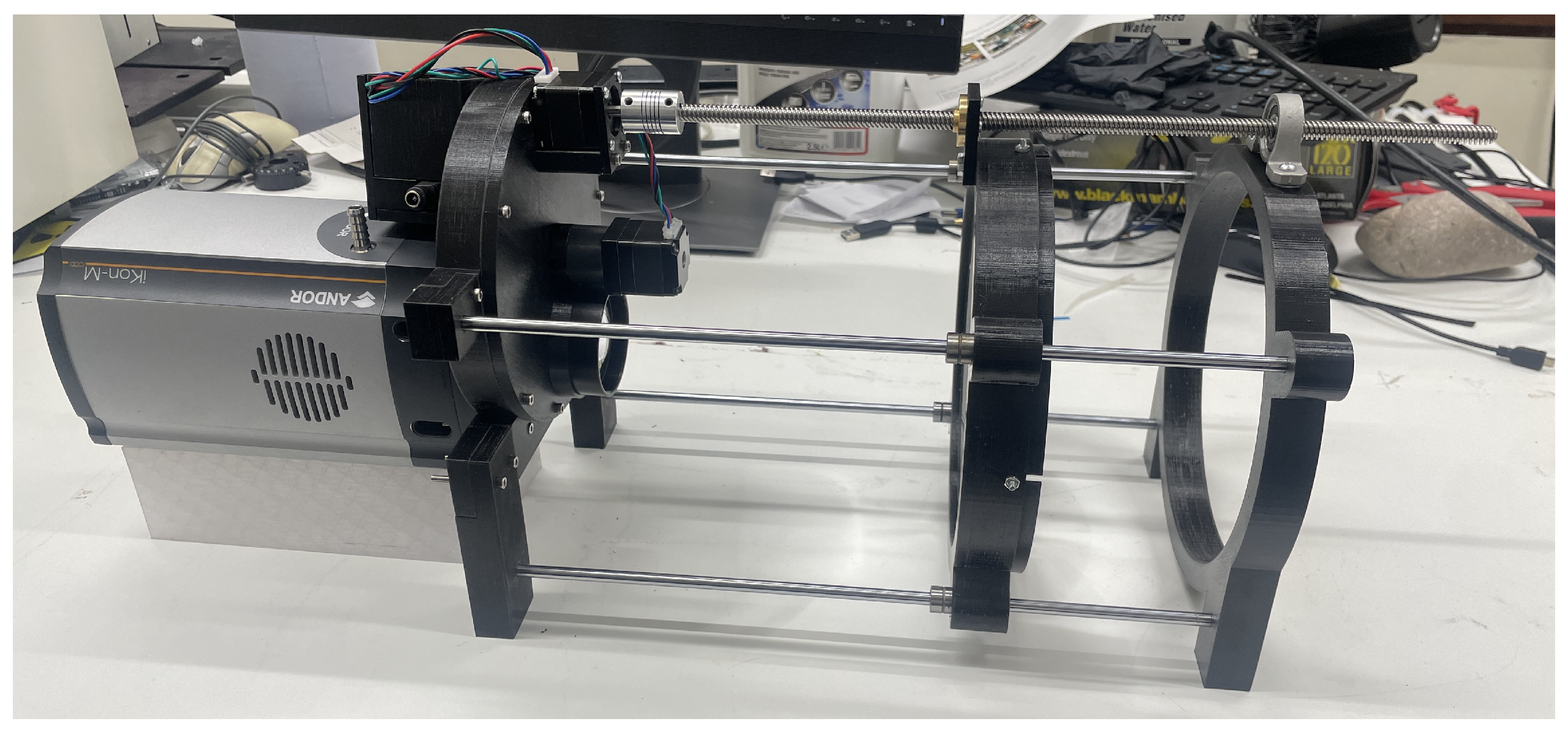
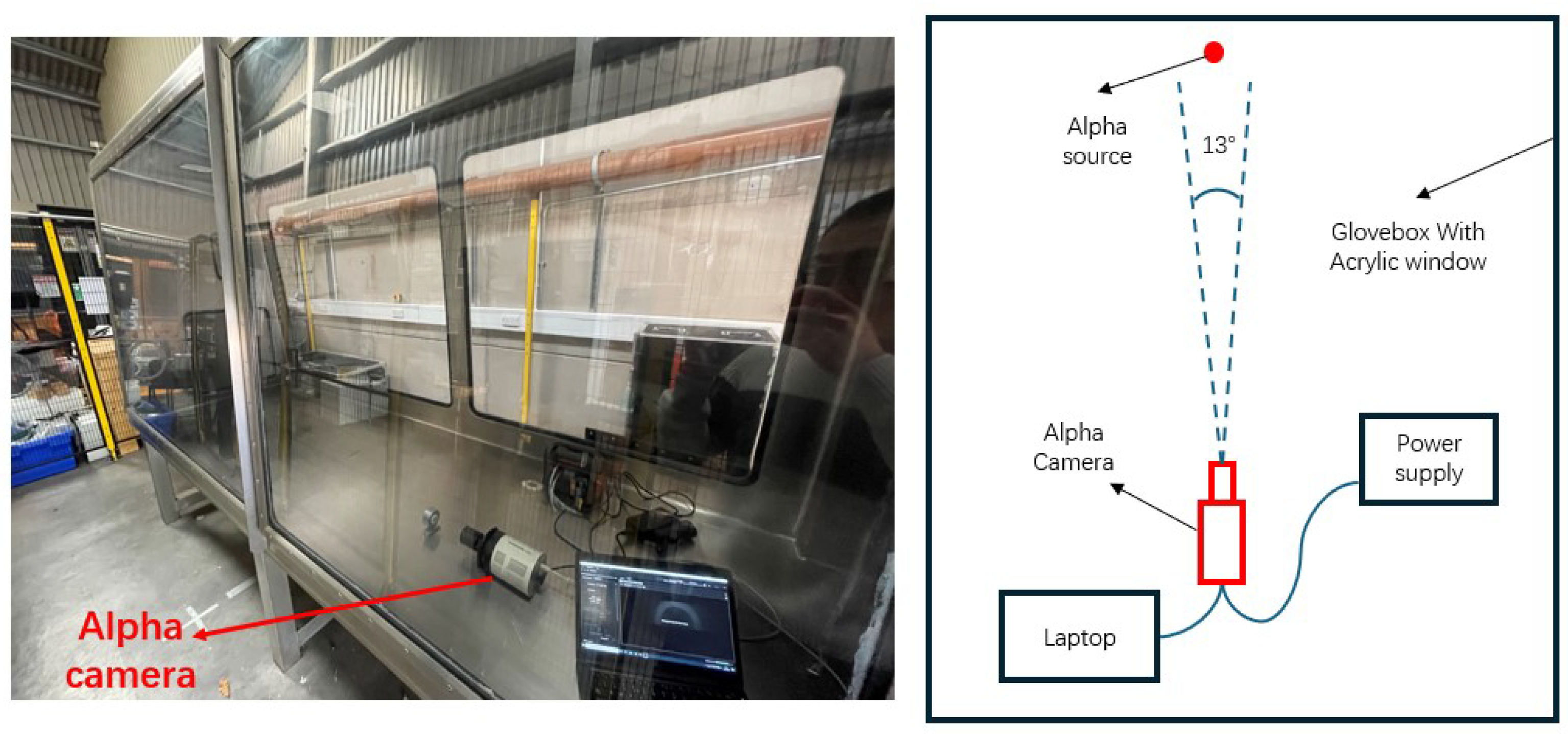


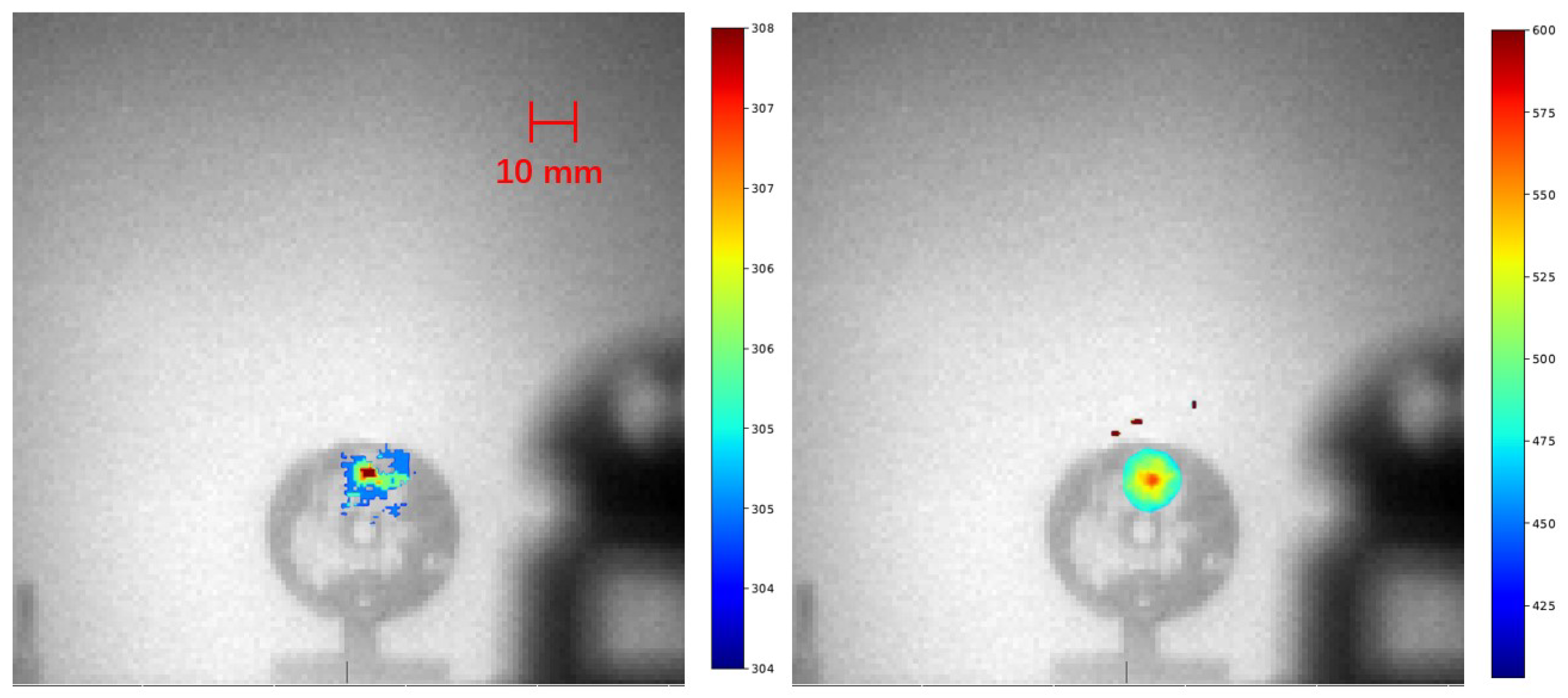



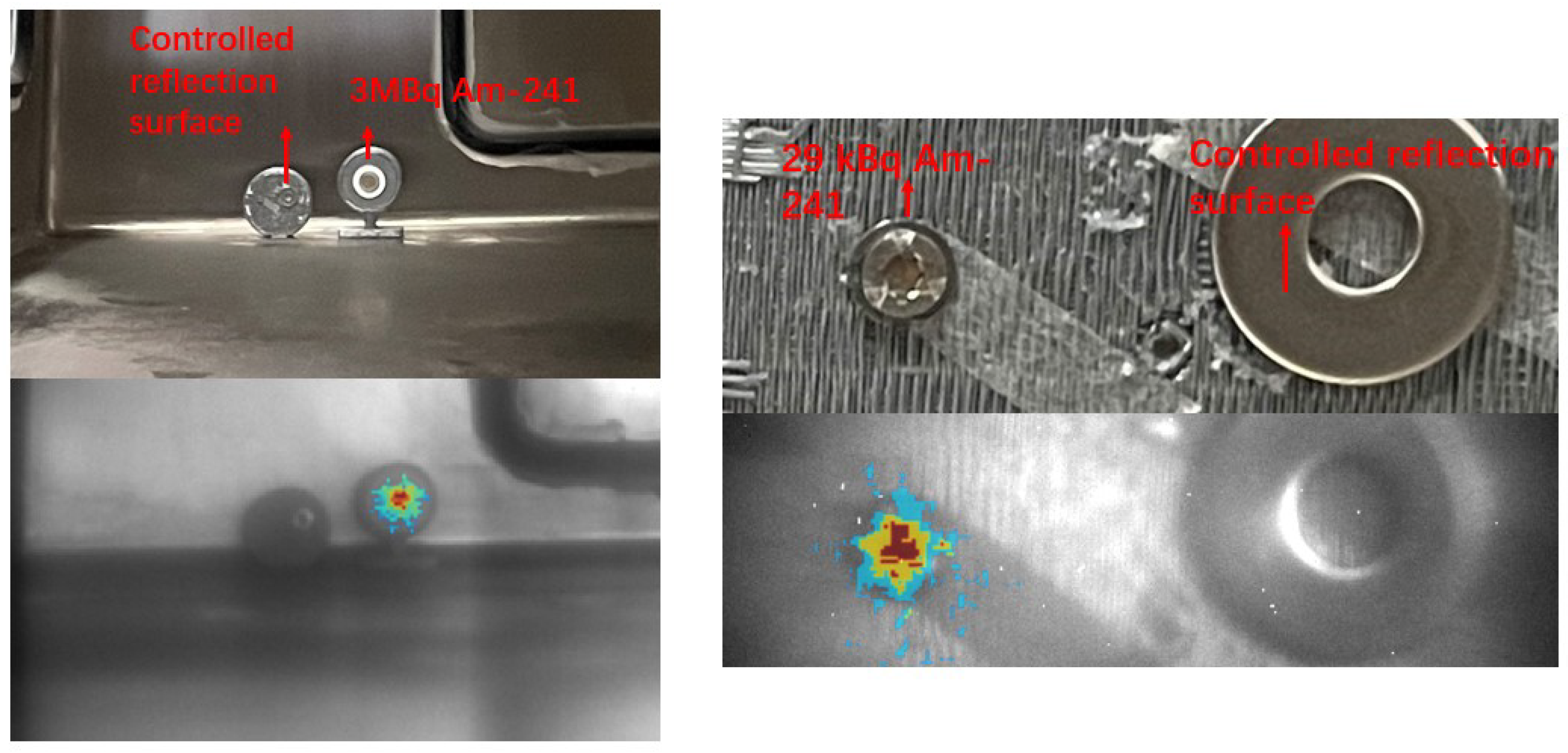
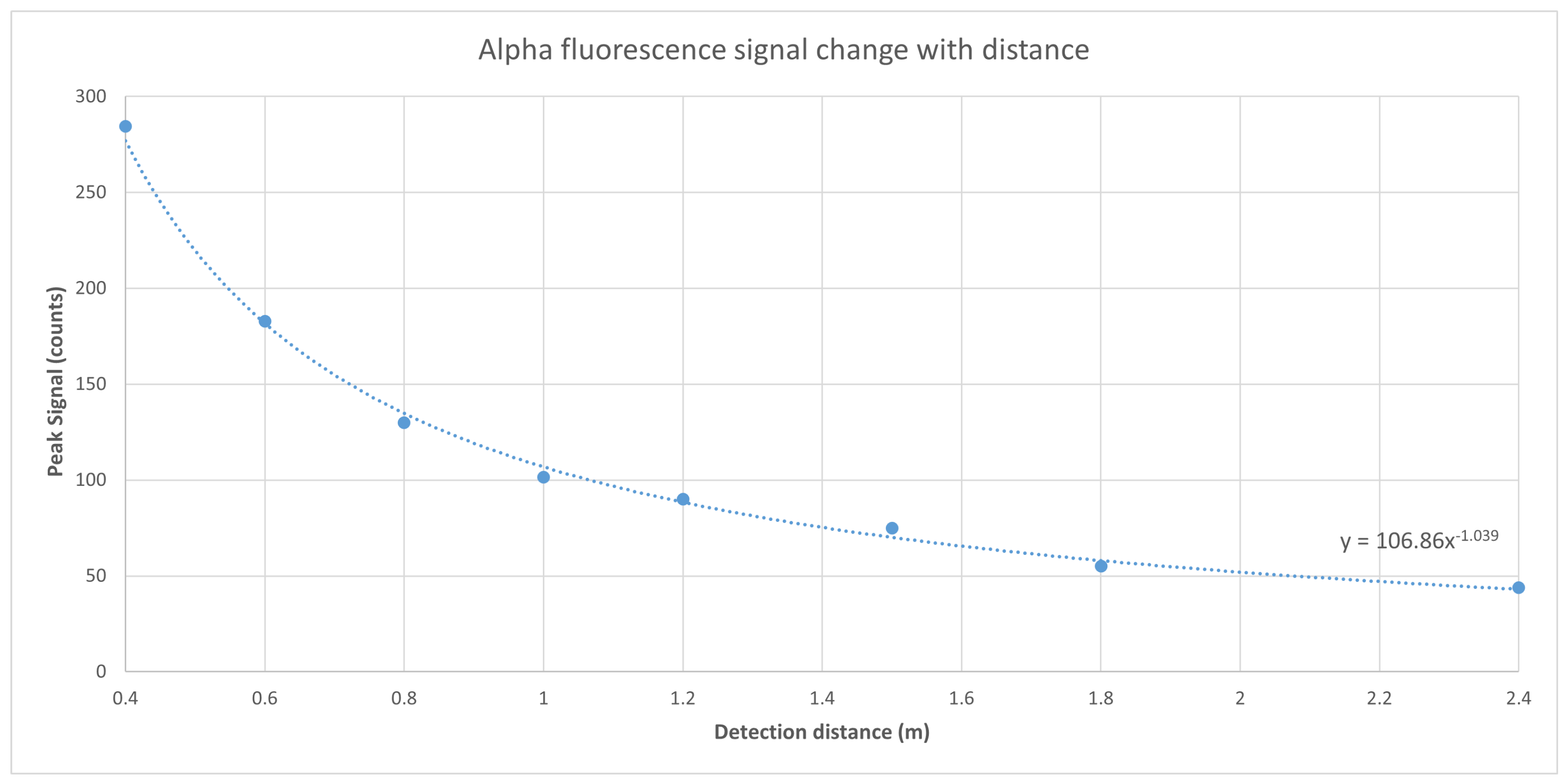
| Filter Name | Seller | Specification | Description |
|---|---|---|---|
| 65–128 | Edmund Optics, York, UK | CWL: 337 nm, FWHM: 10 nm, OD: 4 | Detects alpha RL around 337 nm |
| Hoya U340 | UQG Ltd., Cambridge, UK | Absorptive filter, bandpass: 275–375 nm | Additional filter to block ambient light |
| NEK01 | Thorlabs Ltd., Lancaster, UK | Neutral-density (ND) filter kit | Used for ambient light measurement in various environments |
| FBH450-40 | Thorlabs Ltd., Lancaster, UK | CWL: 450 nm, FWHM: 40 nm, OD: 5 | Capture image in visible band for overlapping with alpha RL signal |
| Light Environment | Primary Light Sources | Blocking Rate Required |
|---|---|---|
| Dark Room (Inside) | Power supply indicators | <OD4 |
| Low Light Room (Inside) | Computer screen, emergency escape light | OD7 |
| Night Time (Outside) | Moonlight, city lights | OD9 |
| Room Light (Inside) | LED or fluorescent light | OD11 |
| Daytime Shade (Outside) | Sunlight | OD13 |
| Indirect Sunlight (Outside) | Sunlight | OD14 |
| Direct Sunlight (Outside) | Sunlight | >OD15 |
| Number of Acrylic Windows Stacked | Acrylic Thickness | Read Count per Pixel per Minute |
|---|---|---|
| 1 | 1.7 mm | 1,320,000 |
| 2 | 3.4 mm | 234,000 |
| 3 | 5.1 mm | 30,000 |
| 4 | 6.8 mm | 4080 |
| 5 | 8.5 mm | 900 |
| 6 | 10.2 mm | 180 |
| 7 | 11.9 mm | 40 |
Disclaimer/Publisher’s Note: The statements, opinions and data contained in all publications are solely those of the individual author(s) and contributor(s) and not of MDPI and/or the editor(s). MDPI and/or the editor(s) disclaim responsibility for any injury to people or property resulting from any ideas, methods, instructions or products referred to in the content. |
© 2024 by the authors. Licensee MDPI, Basel, Switzerland. This article is an open access article distributed under the terms and conditions of the Creative Commons Attribution (CC BY) license (https://creativecommons.org/licenses/by/4.0/).
Share and Cite
Kong, L.; Scott, T.B.; Day, J.C.C.; Megson-Smith, D.A. Advancements in Remote Alpha Radiation Detection: Alpha-Induced Radio-Luminescence Imaging with Enhanced Ambient Light Suppression. Sensors 2024, 24, 3781. https://doi.org/10.3390/s24123781
Kong L, Scott TB, Day JCC, Megson-Smith DA. Advancements in Remote Alpha Radiation Detection: Alpha-Induced Radio-Luminescence Imaging with Enhanced Ambient Light Suppression. Sensors. 2024; 24(12):3781. https://doi.org/10.3390/s24123781
Chicago/Turabian StyleKong, Lingteng, Thomas Bligh Scott, John Charles Clifford Day, and David Andrew Megson-Smith. 2024. "Advancements in Remote Alpha Radiation Detection: Alpha-Induced Radio-Luminescence Imaging with Enhanced Ambient Light Suppression" Sensors 24, no. 12: 3781. https://doi.org/10.3390/s24123781
APA StyleKong, L., Scott, T. B., Day, J. C. C., & Megson-Smith, D. A. (2024). Advancements in Remote Alpha Radiation Detection: Alpha-Induced Radio-Luminescence Imaging with Enhanced Ambient Light Suppression. Sensors, 24(12), 3781. https://doi.org/10.3390/s24123781







